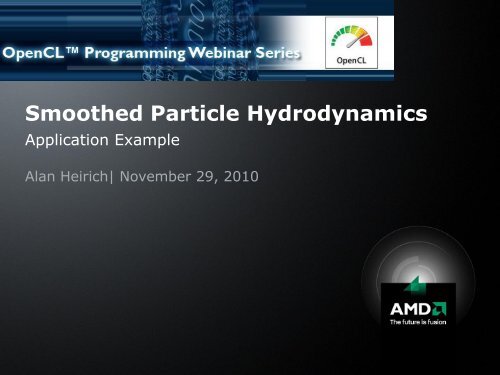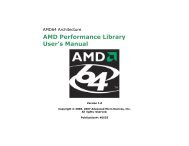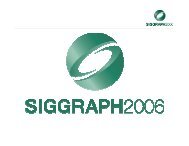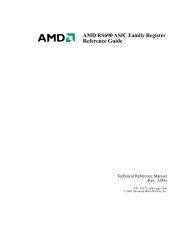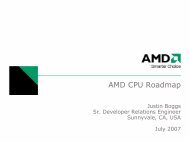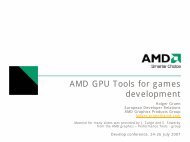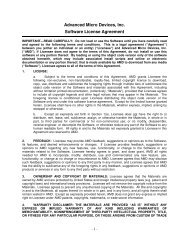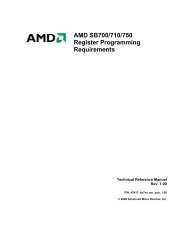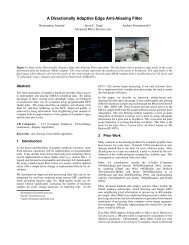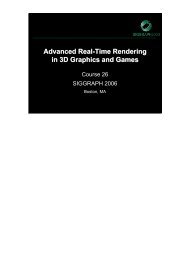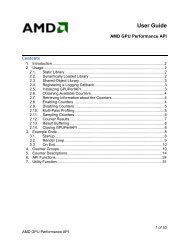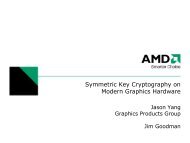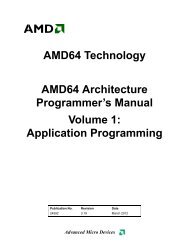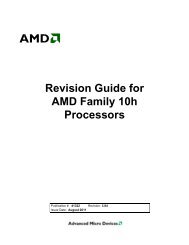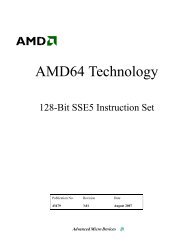Smoothed Particle Hydrodynamics - AMD Developer Central
Smoothed Particle Hydrodynamics - AMD Developer Central
Smoothed Particle Hydrodynamics - AMD Developer Central
Create successful ePaper yourself
Turn your PDF publications into a flip-book with our unique Google optimized e-Paper software.
<strong>Smoothed</strong> <strong>Particle</strong> <strong>Hydrodynamics</strong><br />
Application Example<br />
Alan Heirich| November 29, 2010
Fluids<br />
Navier-Stokes equations<br />
<strong>Smoothed</strong> <strong>Particle</strong> <strong>Hydrodynamics</strong><br />
OpenCL simulation<br />
2 | <strong>Smoothed</strong> <strong>Particle</strong> <strong>Hydrodynamics</strong> | November 2010
Fluids<br />
Liquids, e.g. water<br />
Gasses, e.g. air<br />
Plasmas<br />
3 | <strong>Smoothed</strong> <strong>Particle</strong> <strong>Hydrodynamics</strong> | November 2010
Fluids<br />
Described by (incompressible) Navier-Stokes equations<br />
v<br />
<br />
2<br />
<br />
<br />
v v<br />
g p<br />
v<br />
t<br />
<br />
(<br />
v)<br />
0<br />
<br />
Driven by gravity g, pressure and velocity<br />
– Fluid flows from high pressure to low pressure<br />
– Viscosity µ determines fluid stickiness<br />
Low viscosity: air, water<br />
High viscosity: honey, mud<br />
4 | <strong>Smoothed</strong> <strong>Particle</strong> <strong>Hydrodynamics</strong> | November 2010<br />
p v<br />
2
Fluids<br />
5 | <strong>Smoothed</strong> <strong>Particle</strong> <strong>Hydrodynamics</strong> | November 2010
Fluids<br />
Navier-Stokes equations<br />
<strong>Smoothed</strong> <strong>Particle</strong> <strong>Hydrodynamics</strong><br />
OpenCL simulation<br />
6 | <strong>Smoothed</strong> <strong>Particle</strong> <strong>Hydrodynamics</strong> | November 2010
Incompressible Navier-Stokes equations<br />
v<br />
<br />
2<br />
<br />
<br />
v v<br />
g p<br />
v<br />
t<br />
<br />
<br />
<br />
- density, p – pressure (scalars)<br />
g – gravity, v – velocity (vectors)<br />
v<br />
v<br />
<br />
x y vz<br />
v v<br />
<br />
vx<br />
, vy<br />
, vz<br />
<br />
x<br />
y<br />
z<br />
<br />
convective acceleration<br />
p<br />
p<br />
p<br />
p<br />
, , p = k( - 0 ) resting density 0<br />
x<br />
y<br />
z<br />
<br />
<br />
2<br />
v<br />
<br />
7 | <strong>Smoothed</strong> <strong>Particle</strong> <strong>Hydrodynamics</strong> | November 2010<br />
(<br />
v)<br />
<br />
0<br />
(mass<br />
continuity)<br />
2<br />
v<br />
2<br />
v<br />
2<br />
v<br />
x y z x x<br />
y<br />
z<br />
2 2 2 2<br />
v , v , v , v x<br />
x<br />
x<br />
2 <br />
2 2
Incompressible Navier-Stokes equations<br />
v<br />
<br />
2<br />
<br />
<br />
v v<br />
g p<br />
v<br />
t<br />
<br />
<br />
<br />
– Mass continuity equation:<br />
v<br />
v <br />
<br />
x<br />
v<br />
<br />
x<br />
y<br />
<br />
v<br />
y<br />
<br />
z<br />
<br />
(<br />
v)<br />
<br />
– Mass continuity will be satisfied trivially by using a<br />
particle formulation, since each particle has constant<br />
mass and particles are neither created nor destroyed<br />
8 | <strong>Smoothed</strong> <strong>Particle</strong> <strong>Hydrodynamics</strong> | November 2010<br />
z<br />
<br />
0<br />
0
Incompressible Navier-Stokes equations<br />
v<br />
<br />
2<br />
<br />
<br />
v v<br />
g p<br />
v<br />
t<br />
<br />
<br />
<br />
– The material derivative is the derivative along a path<br />
with velocity v. To simulate with particles take the<br />
material derivative<br />
Dv 2<br />
g<br />
p<br />
<br />
v<br />
Dt<br />
– For a single particle i<br />
dv<br />
dt<br />
i<br />
<br />
g<br />
1 <br />
p<br />
<br />
<br />
<br />
i<br />
9 | <strong>Smoothed</strong> <strong>Particle</strong> <strong>Hydrodynamics</strong> | November 2010<br />
i<br />
2<br />
v
Incompressible Navier-Stokes equations<br />
The Navier-Stokes equations are sensitive to scale, so<br />
we simulate them at 0.004x scale relative to the<br />
physical environment.<br />
10 | <strong>Smoothed</strong> <strong>Particle</strong> <strong>Hydrodynamics</strong> | November 2010
Fluids<br />
Navier-Stokes equations<br />
<strong>Smoothed</strong> <strong>Particle</strong> <strong>Hydrodynamics</strong><br />
OpenCL simulation<br />
11 | <strong>Smoothed</strong> <strong>Particle</strong> <strong>Hydrodynamics</strong> | November 2010
<strong>Smoothed</strong> <strong>Particle</strong> <strong>Hydrodynamics</strong><br />
[Monaghan 1992] introduced smoothing kernels W<br />
( r)<br />
A(<br />
r)<br />
W(<br />
r r,<br />
h)<br />
dr<br />
A(<br />
r ) W(<br />
r r , h)<br />
Ai b b<br />
b<br />
<br />
<br />
And approximations to terms of the N-S equations<br />
<br />
<br />
j<br />
m W(<br />
r r , h)<br />
m – mass, r – position, h - radius<br />
i<br />
j<br />
p p p <br />
i i j<br />
m j W<br />
( r r<br />
2 2<br />
<br />
<br />
i j i<br />
j <br />
j<br />
, h)<br />
<br />
2 v j v i 2<br />
vi m <br />
j W ( r rj,<br />
h)<br />
<br />
<br />
i i<br />
j j <br />
12 | <strong>Smoothed</strong> <strong>Particle</strong> <strong>Hydrodynamics</strong> | November 2010<br />
j
<strong>Smoothed</strong> <strong>Particle</strong> <strong>Hydrodynamics</strong><br />
Over time the literature has converged on these W:<br />
– w = 0 at distance h<br />
– w sums to 1 over sphere of radius h<br />
315<br />
( 9 b<br />
W r r , h)<br />
2<br />
b ( r r<br />
64 h<br />
h <br />
<br />
h r <br />
45<br />
<br />
<br />
W ( r rb<br />
, h)<br />
6 r<br />
h<br />
<br />
( r r h h<br />
<br />
b, ) 6<br />
<br />
b<br />
W r r<br />
h<br />
2 45<br />
13 | <strong>Smoothed</strong> <strong>Particle</strong> <strong>Hydrodynamics</strong> | November 2010<br />
b<br />
2<br />
2<br />
)<br />
3<br />
r<br />
r<br />
<br />
<br />
<br />
<br />
<br />
r<br />
r<br />
b<br />
b
<strong>Smoothed</strong> <strong>Particle</strong> <strong>Hydrodynamics</strong><br />
From Navier-Stokes to SPH:<br />
dv<br />
dt<br />
<br />
i<br />
i<br />
pi<br />
<br />
i<br />
<br />
g<br />
1 2<br />
p<br />
v<br />
<br />
i<br />
i<br />
m ( h rr<br />
j<br />
64<br />
h<br />
j<br />
<br />
<br />
j<br />
m<br />
j<br />
<br />
<br />
p<br />
<br />
<br />
315 9<br />
i<br />
2<br />
i<br />
<br />
p<br />
<br />
j<br />
2<br />
j<br />
<br />
<br />
<br />
<br />
<br />
14 | <strong>Smoothed</strong> <strong>Particle</strong> <strong>Hydrodynamics</strong> | November 2010<br />
2<br />
45 6<br />
h<br />
b<br />
2<br />
)<br />
3<br />
h rr<br />
<br />
2 v <br />
<br />
<br />
<br />
j vi<br />
45<br />
m<br />
h<br />
<br />
i<br />
j(<br />
) 6<br />
<br />
b<br />
j <br />
i<br />
v r r<br />
h<br />
i<br />
j<br />
b<br />
2<br />
r<br />
r<br />
<br />
<br />
r<br />
r<br />
b<br />
b<br />
<br />
<br />
<br />
(1)<br />
(2)<br />
(3)<br />
(4)
Fluids<br />
Navier-Stokes equations<br />
<strong>Smoothed</strong> <strong>Particle</strong> <strong>Hydrodynamics</strong><br />
OpenCL simulation<br />
15 | <strong>Smoothed</strong> <strong>Particle</strong> <strong>Hydrodynamics</strong> | November 2010
OpenCL simulation<br />
Numerical algorithm:<br />
– density = equation (2).<br />
– pressure p = k( - 0)<br />
– pressure gradient = equation (3).<br />
<br />
<br />
<br />
p<br />
– viscous term = equation (4).<br />
– acceleration = equation (1).<br />
i<br />
– numerically integrate velocity, position.<br />
<br />
16 | <strong>Smoothed</strong> <strong>Particle</strong> <strong>Hydrodynamics</strong> | November 2010<br />
2<br />
v<br />
i<br />
i<br />
i
OpenCL simulation<br />
A naïve algorithm computes interactions among all<br />
particles<br />
– Gives correct result because W= 0 for particles beyond<br />
the interaction radius<br />
– But this has complexity O(n^2)<br />
Need an algorithm that only computes interactions among<br />
particles that are within the interaction radius<br />
17 | <strong>Smoothed</strong> <strong>Particle</strong> <strong>Hydrodynamics</strong> | November 2010
OpenCL simulation<br />
A better algorithm partitions space into local regions<br />
– Divide into voxels of size 2h on a side<br />
– Each particle can only interact with particles in the<br />
same voxel, and in immediately adjacent voxels<br />
Total search volume = 2x2x2 voxels<br />
– Further refinement: compute interactions with a<br />
limited number m of particles<br />
m = 32 works well<br />
18 | <strong>Smoothed</strong> <strong>Particle</strong> <strong>Hydrodynamics</strong> | November 2010
OpenCL simulation<br />
The final algorithm:<br />
– Organize particles into voxels<br />
– Compute spatial index from voxel to particles<br />
– For every particle<br />
Examine local region of 2x2x2 voxels<br />
Compute interactions with 32 particles<br />
19 | <strong>Smoothed</strong> <strong>Particle</strong> <strong>Hydrodynamics</strong> | November 2010
OpenCL simulation<br />
Interop allows a buffer to be shared between OpenCL<br />
and a graphics subsystem.<br />
– This avoids an expensive round trip to host memory<br />
– This is crucial for high performance applications<br />
Due to limits of time we did not implement interop in<br />
the graphics code, however we will show you the<br />
OpenCL initialization for interop for reference.<br />
20 | <strong>Smoothed</strong> <strong>Particle</strong> <strong>Hydrodynamics</strong> | November 2010
OpenCL simulation<br />
To interop with dx10 include “cl_d3d10.h” and define<br />
USE_DX_INTEROP<br />
#define USE_DX_INTEROP<br />
#if defined(__APPLE__) || defined(__MACOSX)<br />
#include <br />
#include <br />
#else<br />
#include <br />
#include <br />
#endif<br />
21 | <strong>Smoothed</strong> <strong>Particle</strong> <strong>Hydrodynamics</strong> | November 2010
OpenCL simulation<br />
To interop with dx10 initialize the OpenCL context:<br />
cl_context_properties *cprops;<br />
cprops = new cl_context_properties[ 6 ];<br />
cprops[ 0 ] = CL_CONTEXT_D3D10_DEVICE_KHR;<br />
cprops[ 1 ] = (intptr_t) DXUTGetD3D10Device();<br />
cprops[ 2 ] = CL_CONTEXT_PLATFORM;<br />
cprops[ 3 ] = (cl_context_properties)(platformList[0])();<br />
cprops[ 4 ] = cprops[ 5 ] = 0;<br />
context = cl::Context( CL_DEVICE_TYPE_GPU, cprops, NULL, NULL,<br />
&err);<br />
22 | <strong>Smoothed</strong> <strong>Particle</strong> <strong>Hydrodynamics</strong> | November 2010
OpenCL simulation<br />
Buffers<br />
– position, velocity, acceleration – float4<br />
– particleIndex – uint2<br />
– sortedPosition, sortedVelocity – float4<br />
– gridCellIndex, gridCellIndexFixedUp - uint<br />
Kernels<br />
– hash<strong>Particle</strong>s, sort, sortPostPass<br />
– indexx, indexPostPass<br />
– findNeighbors<br />
– computeDensityPressure, computeAcceleration,<br />
integrate<br />
23 | <strong>Smoothed</strong> <strong>Particle</strong> <strong>Hydrodynamics</strong> | November 2010
OpenCL simulation<br />
The final algorithm:<br />
– Organize particles into voxels<br />
hash<strong>Particle</strong>s, sort, sortPostPass<br />
– Compute spatial index from voxel to particles<br />
indexx, indexPostPass<br />
– For every particle<br />
Examine local region of 2x2x2 voxels<br />
– findNeighbors<br />
Compute interactions with 32 particles<br />
– computeDensityPressure, computeAcceleration, integrate<br />
24 | <strong>Smoothed</strong> <strong>Particle</strong> <strong>Hydrodynamics</strong> | November 2010
OpenCL simulation<br />
Organize particles into voxels: global_id(0)=particle id<br />
– hash<strong>Particle</strong>s:<br />
computes a scalar voxel id from position<br />
– Voxel size 2hx2h<br />
stores voxel id in position.w;<br />
writes {voxel id,global_id(0)} to particleIndex<br />
– sort:<br />
sorts particleIndex by voxel id<br />
– radixSort works only on GPU, use qsort on CPU<br />
– sortPostPass:<br />
rewrite position,velocity into sortedPosition,sortedVelocity<br />
according to order of particleIndex<br />
25 | <strong>Smoothed</strong> <strong>Particle</strong> <strong>Hydrodynamics</strong> | November 2010
OpenCL simulation<br />
Compute spatial index from voxel to particles:<br />
global_id(0) = voxel id<br />
– indexx:<br />
computes gridCellIndex(i), index into sortedPosition of<br />
first particle in voxel i<br />
– Binary search in sortedPosition for lowest particle id<br />
Leave -1 for empty voxels<br />
– indexPostPass:<br />
Fills in index for empty voxels<br />
– gridCellIndex( i ) = gridCellIndex( i+1 ) for i empty, i+1<br />
nonempty<br />
26 | <strong>Smoothed</strong> <strong>Particle</strong> <strong>Hydrodynamics</strong> | November 2010
OpenCL simulation<br />
Examine local region of 2x2x2 voxels:<br />
– findNeighbors:<br />
Locates particle in one corner of 2x2x2 voxel set<br />
Searches up to 8 voxels until 32 neighbors are found<br />
– Retains only neighbors within interaction radius<br />
– Within each voxel search is randomized<br />
Necessary to eliminate biasing artifacts<br />
Specifically, compute random offset within voxel, then proceed<br />
sequentially<br />
Alternate sequential directions according to odd/evenness of particle<br />
27 | <strong>Smoothed</strong> <strong>Particle</strong> <strong>Hydrodynamics</strong> | November 2010
OpenCL simulation<br />
Compute interactions with 32 particles:<br />
– computeDensityPressure:<br />
Equation (2) followed by p = k( - 0 )<br />
– computeAcceleration:<br />
Equations (3), (4), (1)<br />
– integrate:<br />
Semi-implicit Euler integration<br />
v = v + dt a, position = position + dt v<br />
– Boundary conditions prevent particle escape<br />
28 | <strong>Smoothed</strong> <strong>Particle</strong> <strong>Hydrodynamics</strong> | November 2010
Summary<br />
Fluids<br />
– Governed by pressure, velocity<br />
Navier-Stokes equations<br />
– Incompressible equations, material derivative<br />
<strong>Smoothed</strong> <strong>Particle</strong> <strong>Hydrodynamics</strong><br />
– Smoothing kernel approximations<br />
– Approximate , p,<br />
OpenCL simulation<br />
2<br />
<br />
v<br />
– Organize into voxels, create voxel index, compute<br />
equations (2), (3), (4), (1), integrate<br />
29 | <strong>Smoothed</strong> <strong>Particle</strong> <strong>Hydrodynamics</strong> | November 2010
Questions and Answers<br />
Visit the OpenCL Zone on developer.amd.com<br />
http://developer.amd.com/zones/OpenCLZone/<br />
Tutorials, developer guides, and more<br />
OpenCL Programming Webinars page includes:<br />
Schedule of upcoming webinars<br />
On-demand versions of this and past webinars<br />
Slide decks of this and past webinars<br />
Source code for <strong>Smoothed</strong> <strong>Particle</strong> <strong>Hydrodynamics</strong> webinar<br />
30 | <strong>Smoothed</strong> <strong>Particle</strong> <strong>Hydrodynamics</strong> | November 2010
Trademark Attribution<br />
<strong>AMD</strong>, the <strong>AMD</strong> Arrow logo and combinations thereof are trademarks of Advanced Micro Devices, Inc. in the<br />
United States and/or other jurisdictions. Other names used in this presentation are for identification<br />
purposes only and may be trademarks of their respective owners.<br />
©2009 Advanced Micro Devices, Inc. All rights reserved.<br />
31 | <strong>Smoothed</strong> <strong>Particle</strong> <strong>Hydrodynamics</strong> | November 2010


